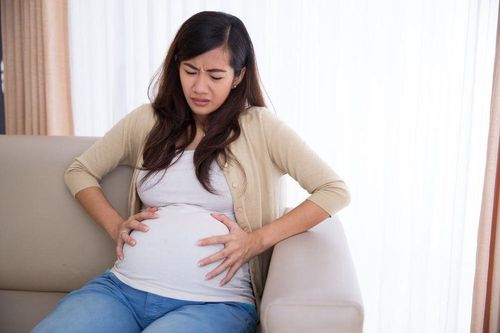This is an automatically translated article.
The article was professionally consulted by Specialist Doctor I Le Thi Phuong - Department of Obstetrics and Gynecology - Vinmec Ha Long International Hospital. Dr. Le Thi Phuong has 29 years of experience in the field of obstetrics and gynecology.Preeclampsia is common in women who are pregnant after 20 weeks and have normal blood pressure. If left untreated, preeclampsia can lead to serious complications, even death, for both the mother and the baby. Therefore, recognizing the early signs of preeclampsia is extremely important for timely intervention to ensure the health of mother and child.
1. Causes of Preeclampsia
The exact cause of preeclampsia involves several factors. Experts believe it begins in the placenta, the organ that nourishes the fetus during pregnancy. Early in pregnancy, new blood vessels develop to efficiently carry blood across the placenta and to the fetus.
In women with preeclampsia, these blood vessels do not develop properly or do not function properly. These blood vessels are narrower than normal blood vessels and have different responses to hormonal signals that limit blood flow.
Causes of this abnormal growth include:
Insufficient blood flow to the uterus. Blood vessel damage. Immune system diseases. Due to genes. Hypertension in pregnancy includes the following clinical forms:
Chronic hypertension (Pre-existing hypertension): Present before or 20 weeks of pregnancy. This condition usually persists for more than 42 days postpartum and may be associated with proteinuria. Gestational hypertension: Appears after 20 weeks of pregnancy and usually resolves within 42 days of delivery. Pre-eclampsia: Fetal hypertension with significant proteinuria [>0.3 g/24 h or albumin:creatinine ratio (ACR) ≥ 30 mg/mmol]. This clinical form occurs more frequently in the first pregnancy, multiple pregnancies, multiple pregnancies, antiphospholipid syndrome or chronic hypertension, kidney disease or diabetes. Preeclampsia is often associated with fetal growth retardation due to placental insufficiency and is a common cause of preterm birth. Because proteinuria can be a late manifestation, the physician should suspect preeclampsia at the onset of hypertension with headache, visual disturbances, abdominal pain, or laboratory abnormalities, especially urine output. low platelet count and/or abnormal liver function. Chronic hypertension plus gestational hypertension with proteinuria. Antenatally unclassifiable hypertension: this term is used when blood pressure is first measured after 20 weeks of pregnancy and hypertension is confirmed; Patients should be reevaluated 42 days postpartum.

2. Risk factors for preeclampsia
Factors that increase the risk of preeclampsia include:
History of preeclampsia: A personal or family history of preeclampsia significantly increases a woman's risk of developing preeclampsia. Chronic hypertension: Women with chronic high blood pressure are at higher risk of developing preeclampsia than women with normal blood pressure. First pregnancy: The risk of developing preeclampsia is highest during a first pregnancy. Having children with a second husband or more: Each pregnancy with a new husband increases the risk of preeclampsia more than a second or third pregnancy with the first husband. Age: The risk of preeclampsia is higher for pregnant teens and pregnant women over 40. Ethnicity: Black women have a higher risk of developing preeclampsia than women of other races. Obesity: The risk of preeclampsia is higher if the woman is obese. Multiple pregnancy: Preeclampsia is more common in women carrying twins, triplets... Gap between pregnancies: Having children less than two years apart or more than 10 years leads to a high risk of preeclampsia. Medical history: Having certain medical conditions prior to pregnancy such as chronic hypertension, migraine headaches, type I or type II diabetes, kidney disease, predisposition to developing blood clots or lupus erythematosus... Both increase the risk of preeclampsia. IVF: A woman's risk of preeclampsia is increased if the baby is conceived using IVF.

3. What are the signs of preeclampsia?
Preeclampsia sometimes develops without any symptoms. High blood pressure may develop slowly or may have a sudden onset. Monitoring the mother's blood pressure is an important part of antenatal care, as the first sign of preeclampsia is often gestational hypertension. Blood pressure in excess of 140/90 mmHg or higher and recorded on two occasions, at least four hours apart, is considered abnormal.
Other signs and symptoms of preeclampsia may include:
Excess protein in your urine (proteinuria) or signs of kidney problems. Severe headache. Changes in vision, including temporary loss of vision, blurred vision, or sensitivity to light. Upper abdominal pain, usually below the ribs on the right side. Nausea or vomiting. Decreased urine output. Decreased level of platelets in the cheeks. Decreased liver function. Shortness of breath Sudden weight gain and swelling, especially in the face and hands. But these also occur in many normal pregnancies, so these symptoms are not considered reliable signs of preeclampsia.
4. Complications of preeclampsia
Fetal growth restriction Preeclampsia affects the arteries that carry blood to the placenta. If the placenta doesn't get enough blood, the fetus may not get enough blood, oxygen, and nutrients. This can lead to slow growth known as fetal growth restriction, low birth weight, or premature birth.
Preterm birth If you have preeclampsia with severe symptoms, you may need to deliver early, to save the life of you and your baby. Premature birth can lead to breathing and other problems for the baby.
Placental abruption Preeclampsia increases the risk of placental abruption, where the placenta separates from the inner wall of the uterus before birth. In severe cases, it can cause severe, life-threatening bleeding for both mother and baby.
HELLP HELLP syndrome is a potentially life-threatening obstetric complication that is often seen as a variant of preeclampsia. Both of these conditions usually occur in late pregnancy, or sometimes postpartum.
Eclampsia When preeclampsia is not controlled, eclampsia consisting of preeclampsia plus seizures is possible. It is difficult to predict which women will develop preeclampsia severe enough to lead to eclampsia. Usually, there are no symptoms or warning signs to predict eclampsia.
Since eclampsia can have serious consequences for both mother and baby, delivery according to the doctor's orders will be performed regardless of how many months pregnant.
Other organ damage Preeclampsia can lead to damage to the kidneys, liver, lungs, heart or eyes and can cause stroke and other brain injuries. The amount of damage to other organs depends on the severity of the preeclampsia.
Cardiovascular disease Preeclampsia can increase your risk of future heart and blood vessel disease. The risk is even greater if a woman has had multiple pre-eclampsia or delivered prematurely.
To reduce this risk, after giving birth, try to maintain an ideal weight, eat a variety of fruits and vegetables, exercise regularly and do not smoke.
Preeclampsia is one of the complications of pregnancy characterized by high blood pressure and signs of damage to other organ systems, usually the liver and kidneys. Routine antenatal check-ups are extremely important to detect signs of preeclampsia, because if you only monitor with common sense, it is easy to confuse preeclampsia with the usual manifestations of pregnancy.
Maternity package i implemented at Vinmec International General Hospital is a high quality maternity care service, receiving absolute trust from pregnant mothers. The program with the aim of best protecting the health of mother and baby during pregnancy will detect abnormalities of both mother and baby early, ensuring a healthy, convenient and comfortable pregnancy.
Please dial HOTLINE for more information or register for an appointment HERE. Download MyVinmec app to make appointments faster and to manage your bookings easily.














